Negative Capacitance Vacuum Channel Transistors for Low Operating Voltage
Abstract
1. Introduction
2. Simulation Method
3. Simulation Results
4. Discussion
5. Conclusions
Funding
Conflicts of Interest
References
- Swift, G.M.; Allen, G.R.; Tseng, C.W.; Carmichael, C.; Miller, G.; George, J.S. Static Upset Characteristics of the 90 nm Virtex-4QV FPGAs. In Proceedings of the IEEE Radiation Effects Data Workshop (REDW), Tucson, AZ, USA, 14–18 July 2008; pp. 98–105. [Google Scholar]
- Gregory, A. Virtex-4QV Static SEU Characterization Summary. In NASA Electronic Parts and Packaging; National Aeronautics and Space Administration: Washington, DC, USA, 2008. [Google Scholar]
- Gregory, A.; Larry, E.; Chen, W.T.; Gary, S.; Carl, C. Error Detect and Correct Enabled Block Random Access Memory (Block RAM) Within the Xilinx XQR5VFX130. IEEE Trans. Nucl. Sci. 2010, 57, 3426–3431. [Google Scholar]
- Muñoz-Quijada, M.; Sanchez-Barea, S.; Vela-Calderon, D.; Guzman-Miranda, H. Fine-Grain Circuit Hardening Through VHDL Datatype Substitution. Electronics 2019, 8, 24. [Google Scholar] [CrossRef]
- Duzellier, S. Radiation effects on electronic devices in Space. Aerosp. Sci. Technol. 2005, 9, 93–99. [Google Scholar] [CrossRef]
- Cai, C.; Fan, X.; Liu, J.; Li, D.; Liu, T.; Ke, L.; Zhao, P.; He, Z. Heavy-ion induced single event upsets in advanced 65 nm radiation hardened FPGAs. Electronics 2019, 8, 323. [Google Scholar] [CrossRef]
- Paul, L. Radiation Tolerant Electronics. Electronics 2019, 8, 730. [Google Scholar]
- Kuwahara, T.; Tomioka, Y.; Fukuda, K.; Sugimura, N.; Sakamoto, Y. Radiation effect mitigation methods for electronic systems. In Proceedings of the 2012 IEEE/SICE International Symposium on System Integration (SII), Fukuoka, Japan, 16–18 December 2012; pp. 307–312. [Google Scholar]
- Selčan, D.; Kirbiš, G.; Kramberger, I. Nanosatellites in LEO and beyond: Advanced Radiation protection techniques for COTS-based spacecraft. Acta Astronaut. 2017, 131, 131–144. [Google Scholar] [CrossRef]
- Furano, G.; Tavoularis, A.; Santos, L.; Ferlet-Cavrois, V.; Boatella, C.; Garcia Alia, R.; Fernandez Martinez, P.; Kastriotou, M.; Wyrwoll, V.; Danzeca, S.; et al. FPGA SEE Test with Ultra-High Energy Heavy Ions. In Proceedings of the 2018 IEEE International Symposium on Defect and Fault Tolerance in VLSI and Nanotechnology Systems (DFT), Chicago, IL, USA, 8–10 October 2018; pp. 1–4. [Google Scholar]
- Zhou, X.; Jia, Y.; Hu, D.; Wu, Y. A simulation-based comparison between Si and SiC MOSFETs on single-event burnout susceptibility. IEEE Trans. Electron Devices 2019, 66, 2551–2556. [Google Scholar] [CrossRef]
- Han, J.; Moon, D.; Meyyappan, M. Nanoscale vacuum channel transistor. Nano Lett. 2017, 17, 2146–2151. [Google Scholar] [CrossRef]
- Srisonphan, S.; Jung, Y.S.; Kim, H.K. Metal–oxide–semiconductor field-effect transistor with a vacuum channel. Nat. Nanotechnol. 2012, 7, 504. [Google Scholar] [CrossRef]
- Han, J.; Oh, J.S.; Meyyappan, M. Cofabrication of vacuum field emission transistor (VFET) and MOSFET. Appl. Phys. Lett. 2014, 13, 464–468. [Google Scholar] [CrossRef]
- Heeger, A.J.; Parker, I.D.; Yang, Y. Carrier injection into semiconducting polymers: Fowler-Nordheim field-emission tunneling. Synth. Met. 1994, 67, 23–29. [Google Scholar] [CrossRef]
- Murphy, E.L.; Good, R. Thermionic emission, field emission, and the transition region. Phys. Rev. 2016, 102, 1464. [Google Scholar] [CrossRef]
- Han, J.; Oh, J.S.; Meyyappan, M. Vacuum nanoelectronics: Back to the future?—Gate insulated nanoscale vacuum channel transistor. Appl. Phys. Lett. 2012, 13, 213505. [Google Scholar] [CrossRef]
- Kim, J.; Kim, J.; Oh, H.; Meyyappan, M.; Han, J.W.; Lee, J.-S. Design guidelines for nanoscale vacuum field emission transistors. J. Vac. Sci. Technol. B Microelectron. 2016, 34, 042201. [Google Scholar] [CrossRef]
- Salahuddin, S.; Datta, S. Use of negative capacitance to provide voltage amplification for low power nanoscale devices. Nano Lett. 2008, 8, 405–410. [Google Scholar] [CrossRef]
- Jain, A.; Alam, M.A. Stability constraints define the minimum subthreshold swing of a negative capacitance field-effect transistor. IEEE Trans. Electron Devices 2014, 61, 2235–2242. [Google Scholar] [CrossRef]
- Rusu, A.; Salvatore, G.A.; Jiménez, D.; Ionescu, A.M. Metal-ferroelectric-meta-oxide-semiconductor field effect transistor with sub-60mV/decade subthreshold swing and internal voltage amplification. In Proceedings of the International Electron Device Meeting (IEDM), San Francisco, CA, USA, 6–8 December 2010. [Google Scholar]
- Khan, A.I.; Yeung, C.W.; Hu, C.; Salahuddin, S. Ferroelectric negative capacitance MOSFET: Capacitance tuning & antiferroelectric operation. In Proceedings of the International Electron Device Meeting (IEDM), Washington, DC, USA, 5–7 December 2011. [Google Scholar]
- Jo, J.; Choi, W.Y.; Park, J.-D.; Shim, J.W.; Yu, H.-Y.; Shin, C. Negative capacitance in organic/ferroelectric capacitor to implement steep switching MOS devices. Nano Lett. 2015, 15, 4553–4556. [Google Scholar] [CrossRef]
- Ko, E.; Lee, H.; Goh, Y.; Jeon, S.; Shin, C. Sub-60-mV/decade negative capacitance FinFET with sub-10-nm hafnium-based ferroelectric capacitor. IEEE J. Electron Devices Soc. 2017, 5, 306–309. [Google Scholar] [CrossRef]
- Ko, E.; Lee, J.W.; Shin, C. Negative capacitance FinFET with sub-20-mV/decade subthreshold slope and minimal hysteresis of 0.48 V. IEEE Electron Device Lett. 2017, 38, 418–421. [Google Scholar] [CrossRef]
- Khan, A.I.; Chatterjee, K.; Duarte, J.P.; Lu, Z.; Sachid, A.; Khandelwal, S.; Ramesh, R.; Hu, C.; Salahuddin, S. Negative capacitance in short channel finFETs externally connected to an epitaxial ferroelectric capacitor. IEEE Electron Device Lett. 2016, 37, 111–114. [Google Scholar] [CrossRef]
- Choe, K.; Shin, C. Adjusting the operating voltage of an nanoelectromechanical relay using negative capacitance. IEEE Trans. Electron Devices 2017, 64, 5270–5273. [Google Scholar] [CrossRef]
- Agarwal, H.; Kushwaha, P.; Duarte, J.P.; Lin, Y.-K.; Sachid, A.B.; Kao, M.-Y.; Chang, H.-L.; Salahuddin, S.; Hu, C. Engineering negative differential resistance in NCFETs for analog applications. IEEE Trans. Electron Devices 2018, 65, 2033–2039. [Google Scholar] [CrossRef]
- Agarwal, H.; Kushwaha, P.; Lin, Y.; Kao, M.; Liao, Y.; Dasgupta, A.; Salahuddin, S.; Hu, C. Proposal for capacitance matching in negative capacitance field-effect transistors. IEEE Electron Device Lett. 2019, 40, 463–466. [Google Scholar] [CrossRef]
- Synopsys, Inc. Sentaurus Device User Guide; Synopsys, Inc.: Mountain View, CA, USA, 2018. [Google Scholar]
- Lee, M.H.; Fan, S.-T.; Tang, C.-H.; Chen, P.-G.; Chou, Y.-C.; Chen, H.-H.; Kuo, J.-Y.; Xie, M.-J.; Liu, S.-N.; Liao, M.-H.; et al. Physical thickness 1.x nm ferroelectric HfZrOx negative capacitance FETs. In Proceedings of the International Electron. Device Meeting (IEDM), San Francisco, CA, USA, 3–7 December 2016. [Google Scholar]
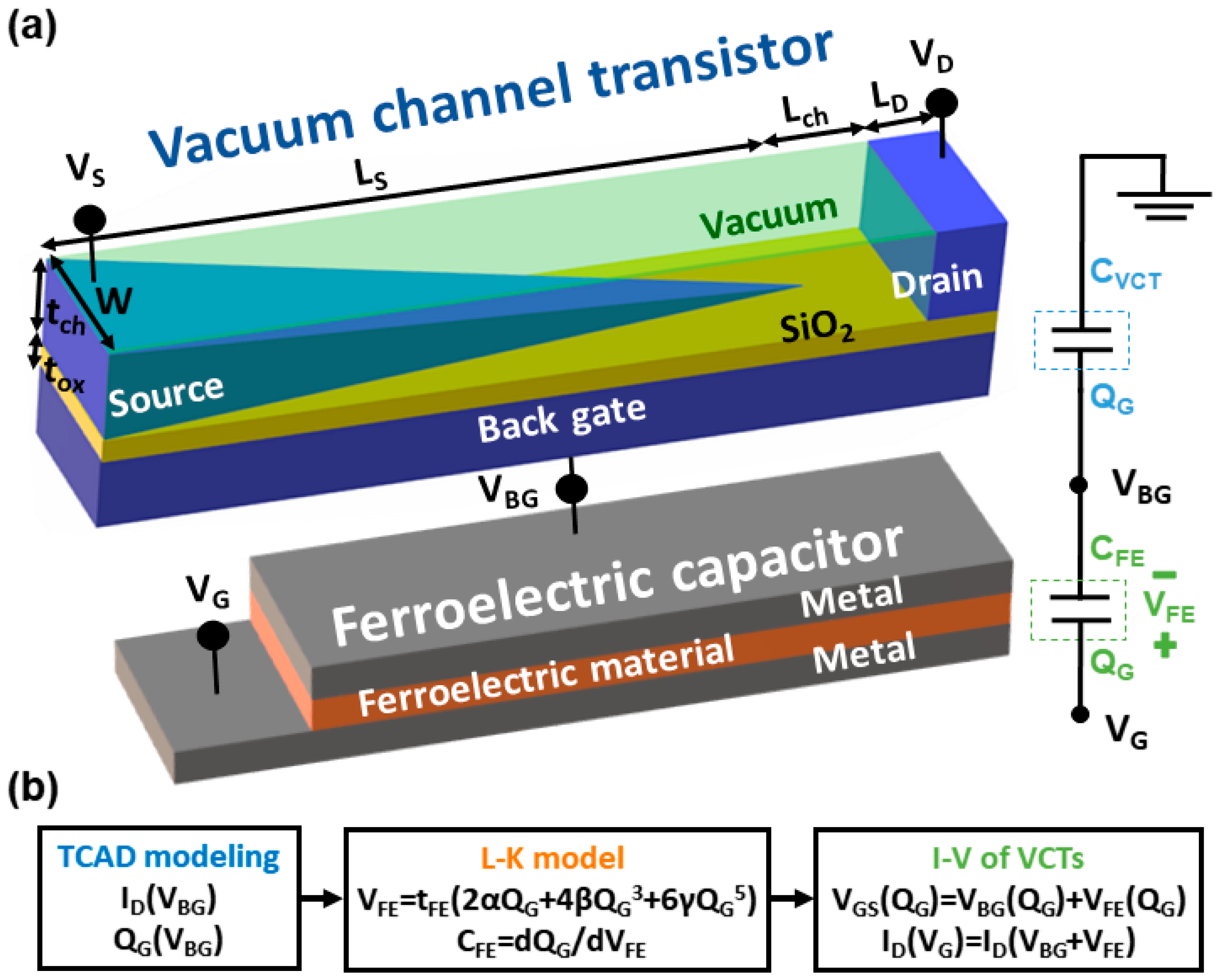
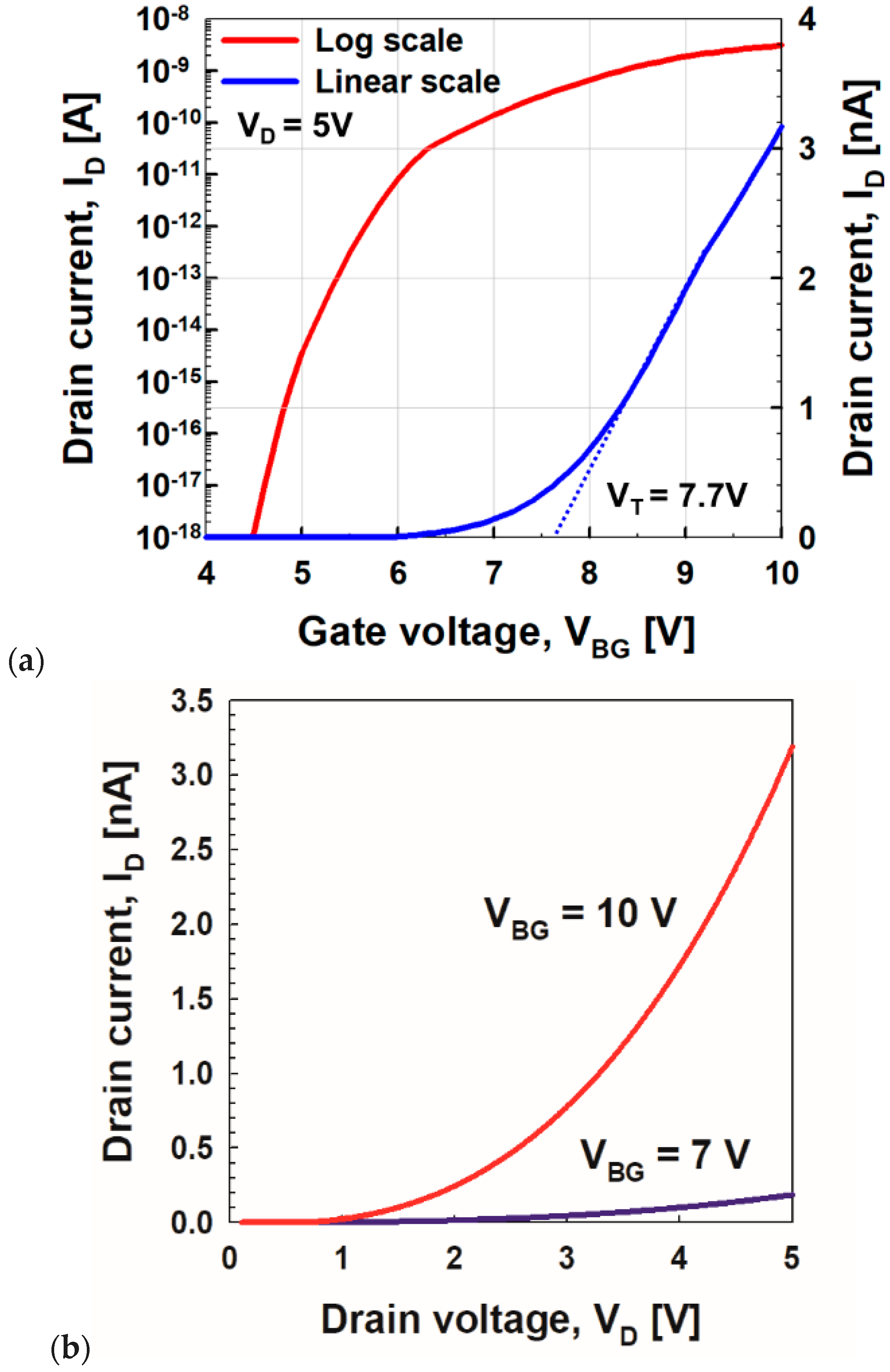


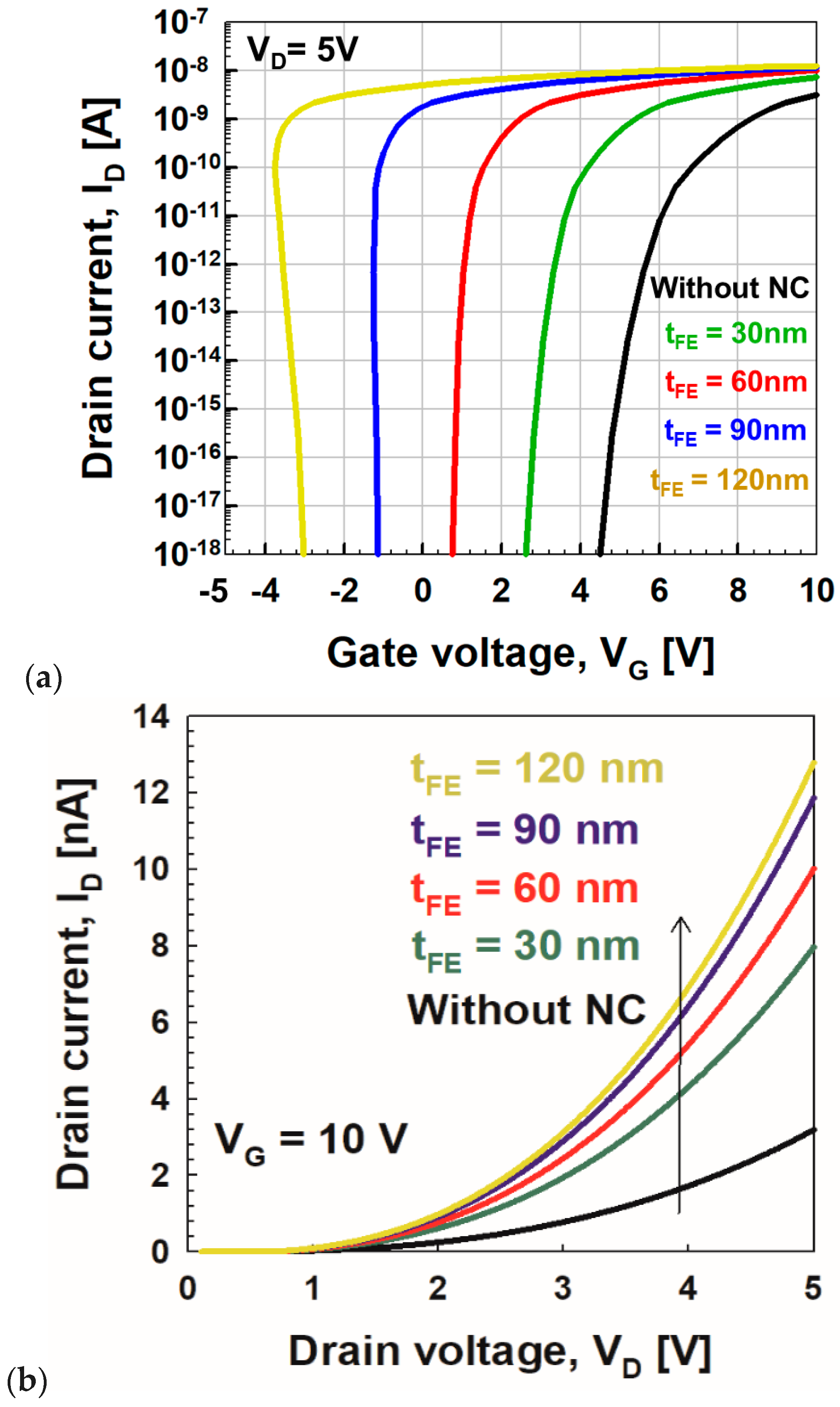
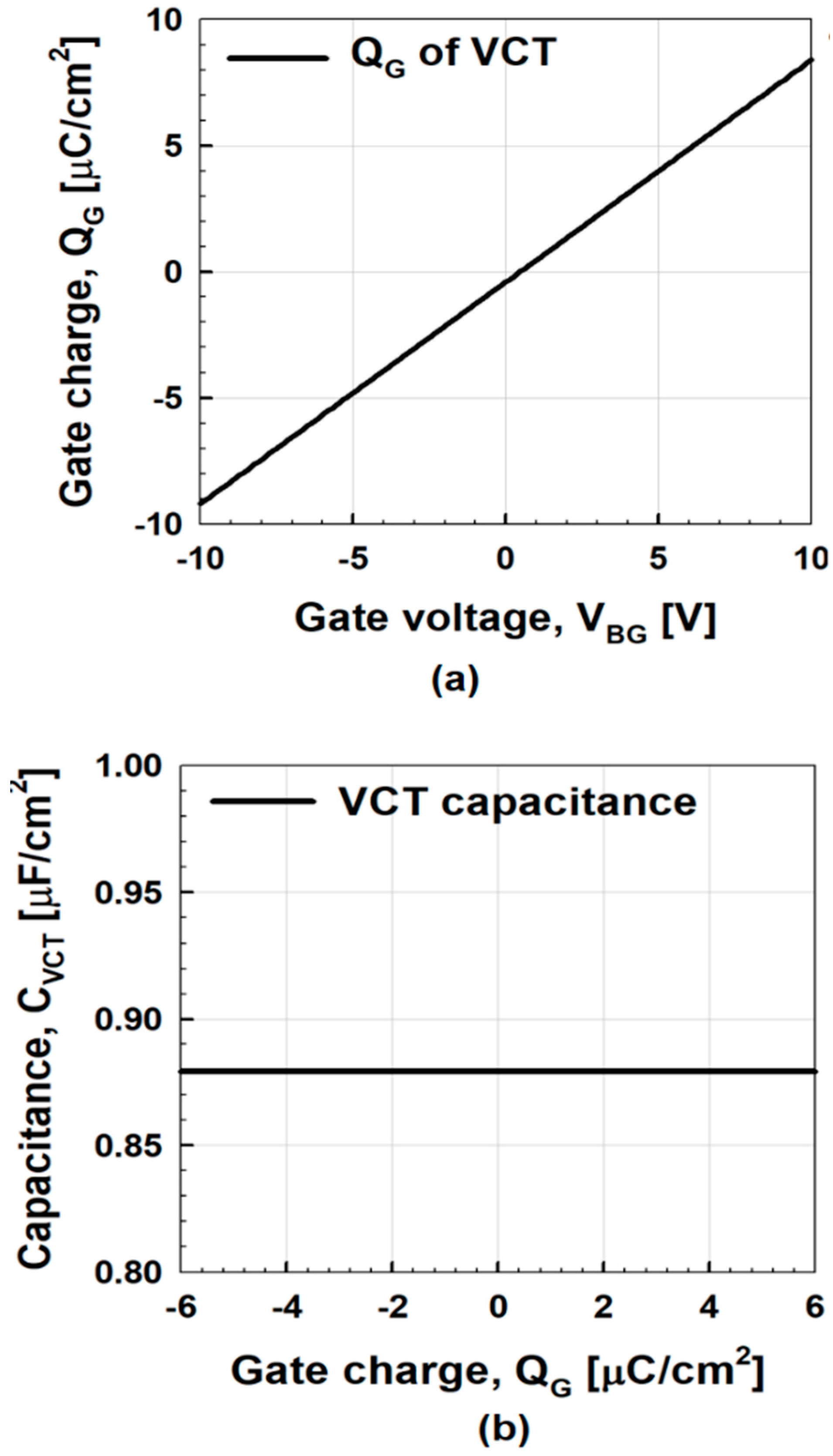
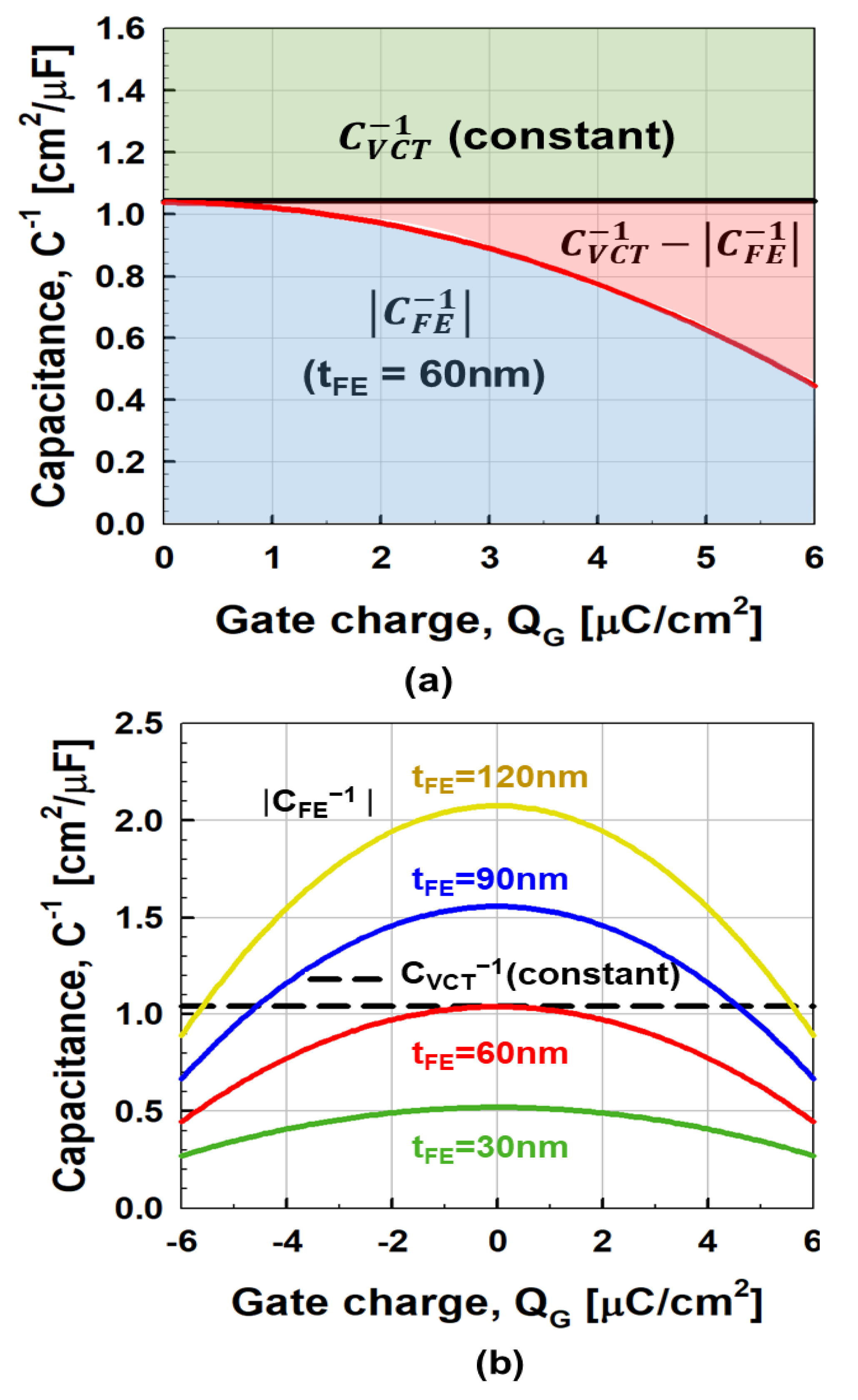
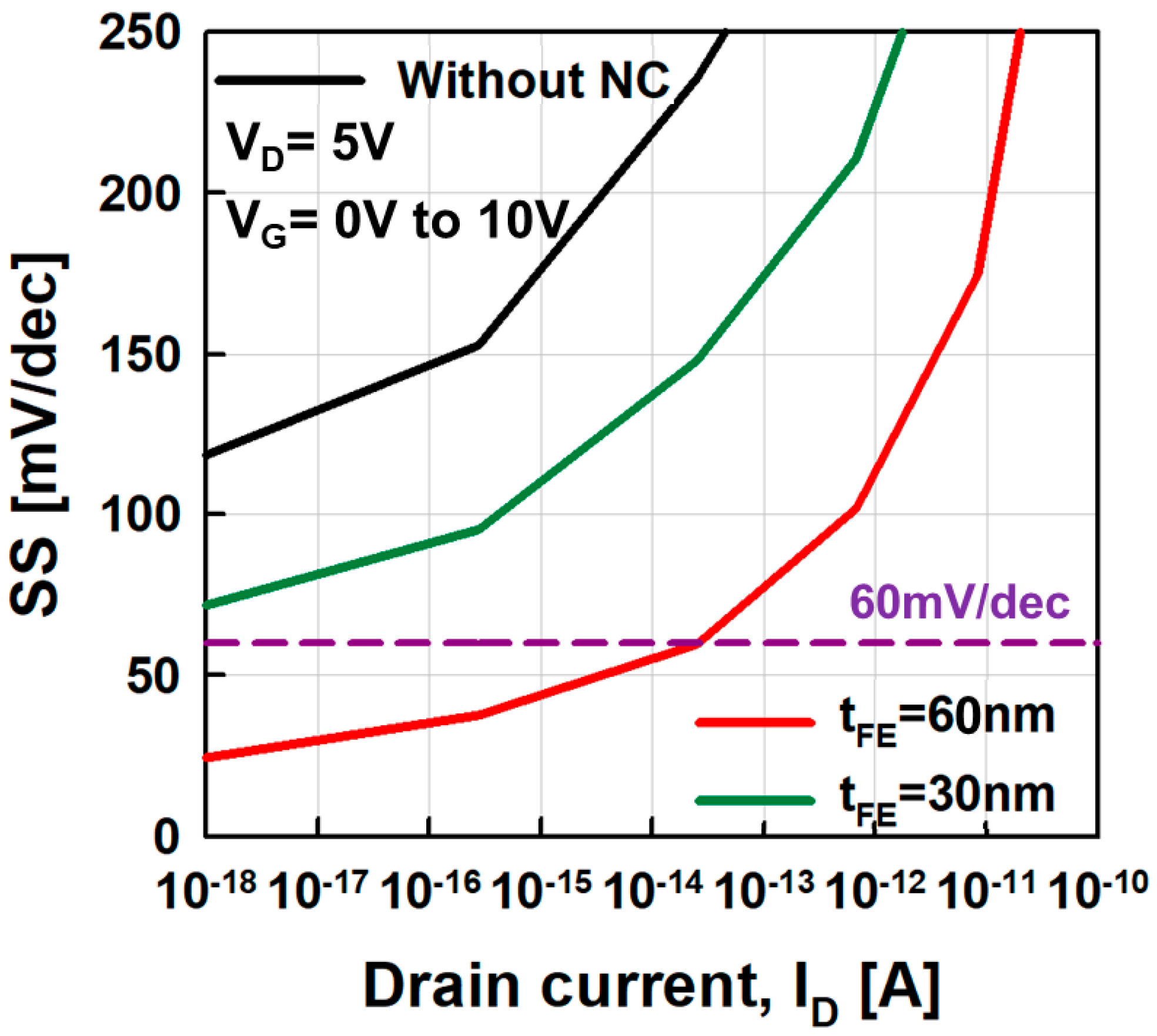
© 2020 by the author. Licensee MDPI, Basel, Switzerland. This article is an open access article distributed under the terms and conditions of the Creative Commons Attribution (CC BY) license (http://creativecommons.org/licenses/by/4.0/).
Share and Cite
Choi, W.Y. Negative Capacitance Vacuum Channel Transistors for Low Operating Voltage. Micromachines 2020, 11, 543. https://doi.org/10.3390/mi11060543
Choi WY. Negative Capacitance Vacuum Channel Transistors for Low Operating Voltage. Micromachines. 2020; 11(6):543. https://doi.org/10.3390/mi11060543
Chicago/Turabian StyleChoi, Woo Young. 2020. "Negative Capacitance Vacuum Channel Transistors for Low Operating Voltage" Micromachines 11, no. 6: 543. https://doi.org/10.3390/mi11060543
APA StyleChoi, W. Y. (2020). Negative Capacitance Vacuum Channel Transistors for Low Operating Voltage. Micromachines, 11(6), 543. https://doi.org/10.3390/mi11060543




